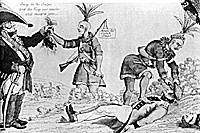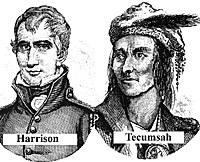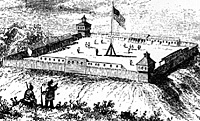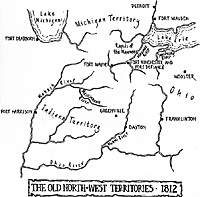Background
The "War of 1812" was an offspring of the larger struggle involving Napoleonic France with most of Europe, including Britain. Fought between Britain and the U.S.A., the war was not popular in the Eastern U.S.A., particularly New England, where a brisk business was being carried out supplying the British in their conflict with Napoleon.
 However, in the Western Territories anti-Indian feeling was high, coupled with the desire to expand the frontier into the Native American lands. There was a feeling that British agents were active among the Natives (as depicted at right in an American propaganda cartoon) and responsible for their mistrust of the Americans. Thus the War was popular in the West as an excuse both to expand the frontier and for completing the War of 1775-83 by adding Canada to the U.S. fold.
However, in the Western Territories anti-Indian feeling was high, coupled with the desire to expand the frontier into the Native American lands. There was a feeling that British agents were active among the Natives (as depicted at right in an American propaganda cartoon) and responsible for their mistrust of the Americans. Thus the War was popular in the West as an excuse both to expand the frontier and for completing the War of 1775-83 by adding Canada to the U.S. fold.
The Native American attitude to the United States had largely been shaped by the Americans land policy or hunger. It appeared to the Natives that the Americans were going to obtain the land either by negotiation or by force.
War Declared
The War was not declared until June 1812, but Governor Meigs of Ohio had pre-empted it and had started to muster a large body of frontier Militia and Regular U.S.Infantry at Dayton. Governor Hull of Michigan Territory was placed in charge of all U.S. forces in the Northwest with the rank of Brigadier General. Unfortunately for the U.S.A. the principal qualifications for military command at the beginning of the War were to have political connections to obtain a commission and the ability to recruit volunteers; in many cases this was to lead to diaster.
The British in Canada were also not wholly unprepared for the War. Under the energetic leadership of General Isaac Brock any preparations that could be made were. But with Britain's main commitment being the European war against Napoleon, few troops and little material could be spared for the defence of Canada.
One particular strength was that they did enjoy the support of many Native Americans particularly from the U.S. side of the border. Though neither side really trusted the other, they both saw mutual support as an advantage. The Natives wanted the British as allies in their struggle to protect their land from the enroaching Americans. The British saw the Natives as allies in any conflict with America, and as a possible buffer state between British Canada and an emerging U.S.A.
The War began disastrously for the Americans. Fort Michilimackinac, controlling the fur trade routes through the Great Lakes, fell to a small body of British Regulars, Canadian Voyageurs and Native Americans. Soon after, Fort Dearborn (present day Chicago) was evacuated by its garrison under orders from General Hull in Detroit, only for them to be killed or captured as they did so by Native Americans.
At the same time General Hull himself surrendered Detroit which included his army of 2,500 men with all their arms and supplies. The British force consisted of 700 Regulars and Militia with 600 Native American allies commanded by General Brock and the great Tecumseh.
Sieges
Harrison ordered reprisals against the local tribes, little or no distinction being given between friendly or hostile natives. Potowatomi and Miami villages were burned, the crops and food storage for the coming winter destroyed. The effect of this destruction virtually finished the already waning influence that the pro-American Miami chiefs had over their warriors. These men could see that their tribes best interest was not served by following their chiefs. Instead they turned to the leadership of Tecumseh, and many of those that had not already done so now joined his cause.
In the meantime the friendly Miamis met with Harrison in October begging for peace. They were told to send five Chiefs to the Americans as hostages until Harrison could take up the matter with the President. The hostages were not sent, the reason probably being the arrival of news telling of another American military failure.
In late September two thousand, 30-day volunteers from Kentucky had enlisted under the command of Major-General Samuel Hopkins, for an expedition against the Natives of Indiana and Illinois territories. By October 14th after two hard weeks in the saddle, this force had found no Natives, their rations had dwindled away and they had become lost. At this point the unseen Natives fired the tall praire grass threatening them with a painful death. Hopkins faced a choice of mutiny or retreat. The Americans retreated.
At about the same time as Hopkins expedition faltered, the Americans underwent yet another defeat. Their invasion of Canada via the Niagara peninsula failed when the U.S. Army was beaten at the battle of Queenston Heights by a combined British force of Regulars, Militia and Native allies. However the British suffered an incalculable loss with the death of Brock during the battle, despite taking over 900 prisoners including Lt. Colonel Winfield Scott.
The only bright note for the Americans at this time was the succesful defence of Fort Harrison by Captain Taylor [4] and a few soldiers and civilians, many of whom were sick, against repeated attacks by Miami and Wea warriors until relief arrived. It was the U.S.A.'s first land Victory and won Taylor the first brevet commission awarded by the U.S.government.
Harrison still had the Miami problem on his mind, however. Writing to the Secretary of War at the end of October, Harrison was of the opinion that the Miami should be given,"... a severe chastisement...It remains for the President to say what should be done with the Miamis...Nothing could be more easy than to surprise the Miami town of Mississineway with mounted men. I have engaged General McArthur to undertake it." McArthur had to turn down acceptance of the command as it would violate his parole [5] and the command instead was given to Lt.Colonel J.B. Campbell. [6]
After the surrender of Detroit, Harrison had been appointed to command the Army of the Northwest. He was charged with subduing the Natives, relieving Detroit and invading Canada. Harrison's strategy was to move his army to the foot of the "Rapids of the Maumee", in three columns and from there strike at Detroit. Winchester, protecting the left flank, would march along the route of the Maumee river from the new fort that bore his name. A central force of 1200 men would follow General Hull's old road to the same place. Harrison's right division would march from Wooster in Ohio to the rapids by way of the Upper Sandusky river.
Grand Strategy?
This grand strategy soon began to become unstuck. In November Winchester was pinned down at Fort Winchester by the lack of supplies, conditions not being helped by the onset of wintery conditions. This was followed in early November by the news of another failure by Hopkins who had attempted to attack the Native tribes of the upper Wabash river. [7]
Hopkins' failure left Harrison's left flank open to attack as he drove towards Detroit and Canada. He therefore decided to forestall any further attacks on Winchester's line of communications by striking at the Miami villages and towns along the Mississenawa river. The proposed Mississineway expedition already advocated by Harrison was ordered to be implemented immediately.
The Miami town of Mississineway was located near the junction of the Mississenawa and Wabash rivers. Generally known as the Osage village it had been a town of some importance to the Natives for many years. This town and other nearby settlements were the safest part of Miami territory left to them and probably contained the bulk of their winter food. The Miami's concentration in this area during the winter of 1812 was due to these reasons. The Mississenawa area also provided an effective rendezvous for the Natives from upper Illinois and the southern shore of Lake Michigan to launch attacks on Fort Wayne and supply convoys supporting any future American campaigns.
In addition to these reasons, Harrison needed a victory or at least a convincing show of aggression as his forces had not been engaged in any action since he had taken overall command.
Campbell was instructed to avoid the Delawares, who were thought to be complying with an order to leave their villages and join the Shawnee on the Auglaize river. He was also to spare the lives of the friendly Miami Chiefs, Richardville, Pecan, Silver Heels, White Loon, the Sons and brothers of Little Turtle, and the French trader James Godfrey who lived at Mississineway. After destroying the town and villages, Campbell could then proceed north and destroy the Potawatomi Village of White Pigeon and engage in such adventures as he might seem advisable. William Conner, a trader was provided as a guide, along with six other men. It was felt that a number of otherwise indifferent guides could, by pooling their knowledge in some way, equal a competent one.
More Mississenawa
 One of the principal land speculators was William Henry Harrison, [1] whose activities had made him a fortune. One of his treaties with the Natives provided him over 3 million acres of choice hunting grounds along the lower Wabash river. The Native Americans had a different concept of land ownership believing that nobody owned the land, that it belonged to all. Alarmed by the enroaching whites many Natives rallied under the leadership of the Shawnee Cheftain, Tecumseh, [2] and his brother the "Prophet".
One of the principal land speculators was William Henry Harrison, [1] whose activities had made him a fortune. One of his treaties with the Natives provided him over 3 million acres of choice hunting grounds along the lower Wabash river. The Native Americans had a different concept of land ownership believing that nobody owned the land, that it belonged to all. Alarmed by the enroaching whites many Natives rallied under the leadership of the Shawnee Cheftain, Tecumseh, [2] and his brother the "Prophet".
 Thus encouraged, in September 1812 other Native Americans undertook sieges of various U.S.frontier posts including Fort Wayne (shown at right). Warriors from the Miami tribe were involved in this siege. The garrison however was well supplied and, despite the local commander having a drink problem, [3] withstood a siege of 10 days before being relieved by an army of 2,200 men commanded by the ex-land speculator General Harrison.
Thus encouraged, in September 1812 other Native Americans undertook sieges of various U.S.frontier posts including Fort Wayne (shown at right). Warriors from the Miami tribe were involved in this siege. The garrison however was well supplied and, despite the local commander having a drink problem, [3] withstood a siege of 10 days before being relieved by an army of 2,200 men commanded by the ex-land speculator General Harrison.

Back to Age of Napoleon No. 23 Table of Contents
Back to Age of Napoleon List of Issues
Back to MagWeb Master List of Magazines
© Copyright 1997 by Partizan Press.
This article appears in MagWeb (Magazine Web) on the Internet World Wide Web.
Other military history articles and gaming articles are available at http://www.magweb.com